Celery
From Wikipedia, the free encyclopedia
For the software see Celery Task Queue

| Celery | |
|---|---|
| Scientific classification | |
| Kingdom: | Plantae |
| (unranked): | Angiosperms |
| (unranked): | Eudicots |
| (unranked): | Asterids |
| Order: | Apiales |
| Family: | Apiaceae |
| Genus: | Apium |
| Species: | A. graveolens |
| Variety: | dulce (Mill.) Pers. |
| Synonyms[1] | |
| |
Celery (Apium graveolens var. dulce) is a plant variety in the family Apiaceae, commonly used as a vegetable. The plant grows to 1 m tall. The leaves are pinnate to bipinnate leaves with rhombic leaflets 3–6 cm long and 2–4 cm broad. The flowers are creamy-white, 2–3 mm diameter, produced in dense compound umbels. The seeds are broad ovoid to globose, 1.5–2 mm long and wide.
Etymology
First attested in English 1664, the word "celery" derives from the French céleri, in turn from Italian seleri, the plural of selero, which comes from Late Latin selinon,[2] the latinisation of the Greek σέλινον (selinon), "parsley".[3][4] The earliest attested form of the word is the Mycenaean Greek se-ri-no, written in Linear B syllabic script.[5]
[edit]Taxonomy
[edit]Cultivation
In North America, commercial production of celery is dominated by the varieties called Pascal celery.[7]Gardeners can grow a range of cultivars, many of which differ little from the wild species, mainly in having stouter leaf stems. They are ranged under two classes, white and red; the white cultivars being generally the best flavoured, and the most crisp and tender. The stalks grow in tight, straight, parallel bunches, and are typically marketed fresh that way, without roots and just a little green leaf remaining.
The wild form of celery is known as "smallage". It has a furrowed stalk with wedge-shaped leaves, the whole plant having a coarse, earthy taste, and a distinctive smell. The stalks are not usually eaten (except in soups or stews in French cuisine), but the leaves may be used in salads, and its seeds are those sold as a spice.[8]With cultivation and blanching, the stalks lose their acidic qualities and assume the mild, sweetish, aromatic taste particular to celery as a salad plant.
The plants are raised from seed, sown either in a hot bed or in the open garden according to the season of the year, and after one or two thinnings and transplantings, they are, on attaining a height of 15–20 cm, planted out in deep trenches for convenience of blanching, which is effected by earthing up to exclude light from the stems.
In the past, celery was grown as a vegetable for winter and early spring; it was perceived as a cleansing tonic, welcomed to counter the salt-sickness of a winter diet. By the 19th century, the season for celery had been extended, to last from the beginning of September to late in April.[9]
[edit]Harvesting and storage
Harvesting occurs when the average size of celery in a field is marketable; due to extremely uniform crop growth, fields are harvested only once. Thepetioles and leaves are removed and harvested; celery is packed by size and quality (determined by colour, shape, straightness and thickness of petiole, stalk and midrib[clarification needed] length and absence of disease, cracks, splits, insect damage and rot). Under optimal conditions, celery can be stored for up to seven weeks between 0 to 2 °C (32 to 36 °F). Inner stalks may continue growing if kept at temperatures above 0 °C (32 °F). Freshly cut petioles of celery are prone to decay, which can be prevented or reduced through the use of sharp blades during processing, gentle handling, and proper sanitation.[10]
Cut pieces of celery last only a few hours before they turn brown, and few American restaurants include it in green salads because it cannot be prepared far enough ahead of time. In the past, restaurants used to store it in a container of water with powdered vegetable preservative; however, thesulfites in the preservative caused allergic reactions in some people.[11] In 1986, the U.S. Food and Drug Administration banned the use of sulfites on fruits and vegetables intended to be eaten raw.[12]
[edit]Uses
Celery is used around the world as a vegetable for the crisp petiole (leaf stalk). The leaves are strongly flavoured and are used less often, either as a flavouring in soups and stews or as a dried herb.
In temperate countries, celery is also grown for its seeds. Actually very small fruit, these "seeds" yield a valuable volatile oil used in the perfume and pharmaceutical industries. They also contain an organic compound called apiol. Celery seeds can be used as flavouring or spice, either as whole seeds or ground and mixed with salt, as celery salt. Celery salt can also be made from an extract of the roots, or using dried leaves. Celery salt is used as a seasoning, in cocktails (notably to enhance the flavour of Bloody Mary cocktails), on the Chicago-style hot dog, and in Old Bay Seasoning.
Celery, onions, and bell peppers are the holy trinity of Louisiana Creole and Cajun cuisine. Celery, onions, and carrots make up the French mirepoix, often used as a base for sauces and soups. Celery is a staple in many soups, such as chicken noodle soup.
[edit]Medicine
The use of celery seed in pills for relieving pain was described by Aulus Cornelius Celsus around 30 AD.[13] Celery seeds contain a compound, 3-n-butylphthalide, that has been demonstrated to lower blood pressure in rats.[14]
Bergapten in the seeds can increase photosensitivity, so the use of essential oil externally in bright sunshine should be avoided. The oil and large doses of seeds should be avoided during pregnancy, as they can act as a uterine stimulant. Seeds intended for cultivation are not suitable for eating as they are often treated with fungicides.
[edit]Nutrition
| Nutritional value per 100 g (3.5 oz) | |
|---|---|
| Energy | 16 kcal (67 kJ) |
| Carbohydrates | 3 g |
| - Sugars | 1.4 g |
| - Dietary fibre | 1.6 g |
| Fat | 0.2 g |
| Protein | 0.7 g |
| Water | 95 g |
| Vitamin A equiv. | 22 μg (3%) |
| Thiamine (vit. B1) | 0.021 mg (2%) |
| Riboflavin (vit. B2) | 0.057 mg (5%) |
| Niacin (vit. B3) | 0.323 mg (2%) |
| Vitamin B6 | 0.076 mg (6%) |
| Folate (vit. B9) | 36 μg (9%) |
| Vitamin C | 3 mg (4%) |
| Vitamin E | 0.27 mg (2%) |
| Vitamin K | 29.3 μg (28%) |
| Calcium | 40 mg (4%) |
| Iron | 0.2 mg (2%) |
| Magnesium | 11 mg (3%) |
| Phosphorus | 24 mg (3%) |
| Potassium | 260 mg (6%) |
| Sodium | 80 mg (5%) |
| Zinc | 0.13 mg (1%) |
| Percentages are relative to US recommendations for adults. Source: USDA Nutrient Database | |
Celery is used in weight-loss diets, where it provides low-calorie dietary fibre bulk. Celery is often purported to be a "negative calorie food" based on the idea that the body will burn more calories during the digestion of the food than the body can extract from the food itself. The fact that the body uses very small amounts of energy in digestion compared to what can be extracted even from a low calorie food like celery disproves this hypothesis.[15] [16]
[edit]Allergies
Celery is among a small group of foods (headed by peanuts) that appear to provoke the most severe allergic reactions; for people with celery allergy, exposure can cause potentially fatal anaphylactic shock.[17] The allergen does not appear to be destroyed at cooking temperatures. Celery root—commonly eaten as celeriac, or put into drinks—is known to contain more allergen than the stalk. Seeds contain the highest levels of allergen content.Exercise-induced anaphylaxis may be exacerbated. An allergic reaction also may be triggered by eating foods that have been processed with machines that have previously processed celery, making avoiding such foods difficult. In contrast with peanut allergy being most prevalent in the US, celery allergy is most prevalent in Central Europe.[18] In the European Union, foods that contain or may contain celery, even in trace amounts, must be clearly marked as such.[19]
[edit]Chemistry
Polyacetylenes can be found in Apiaceae vegetables like celery where they show cytotoxic activities.[20]
[edit]History
Daniel Zohary and Maria Hopf[21] note that celery leaves and inflorescences were part of the garlands found in the tomb of pharaoh Tutankhamun (died 1323 BC), and celery mericarps dated to the seventh century BC were recovered in the Heraion of Samos. However, they note "since A. graveolensgrows wild in these areas, it is hard to decide whether these remains represent wild or cultivated forms." Only by classical times is it certain that celery was cultivated.
M. Fragiska mentions an archeological find of celery dating to the 9th century BC, at Kastanas; however, the literary evidence for ancient Greece is far more abundant. In Homer's Iliad, the horses of the Myrmidons graze on wild celery that grows in the marshes of Troy, and in Odyssey, there is mention of the meadows of violet and wild celery surrounding the cave of Calypso.[22]
[edit]Cultural depictions
A chthonian symbol among the ancient Greeks, celery was said to have sprouted from the blood of Kadmilos, father of the Cabeiri, chthonian divinities celebrated in Samothrace, Lemnos and Thebes. The spicy odour and dark leaf colour encouraged this association with the cult of death. In classical Greece, celery leaves were used as garlands for the dead, and the wreaths of the winners at the Isthmian Games were first made of celery before being replaced by crowns made of pine. According to Pliny the Elder[23] in Achaea, the garland worn by the winners of the sacred Nemean Gameswas also made of celery.[22] The Ancient Greek colony of Selinous (Greek: Σελινοῦς, Selinoūs), on Sicily, was named after wild parsley that grew abundantly there; Selinountian coins depicted a parsley leaf as the symbol of the city.
The name "celery" retraces the plant's route of successive adoption in European cooking, as the English "celery" (1664) is derived from the Frenchcéleri coming from the Lombard term, seleri, from the Latin selinon, borrowed from Greek.[24]
Celery's surprisingly late arrival in the English kitchen is an end-product of the long tradition of seed selection needed to reduce the sap's bitterness and increase its sugars. By 1699, John Evelyn could recommend it in his Acetaria. A Discourse of Sallets: "Sellery, apium Italicum, (and of the Petroseline Family) was formerly a stranger with us (nor very long since in Italy) is an hot and more generous sort of Macedonian Persley or Smallage...and for its high and grateful Taste is ever plac'd in the middle of the Grand Sallet, at our Great Men's tables, and Praetors feasts, as the Grace of the whole Board".
Celery has made a surprising appearance in football folklore. Supporters of English Premier League team Chelsea and Football League teamGillingham regularly sing songs about the vegetable and are famed for throwing celery during matches. This has also given rise to the "Chelsea Cocktail", a pint of Guinness garnished with a stick of celery.
In the television program Doctor Who, the Fifth incarnation of The Doctor (played by Peter Davison), was noted[citation needed] for wearing a stalk of celery on his lapel, claiming it at one point[clarification needed] to be an excellent restorative,[disambiguation needed] though the human olfactory sense was comparatively weak.[clarification needed]
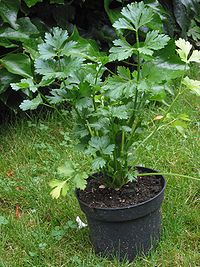
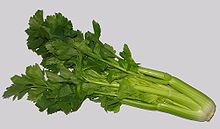
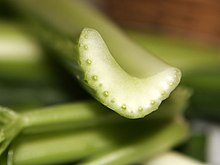

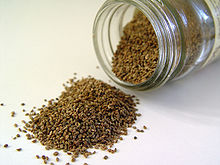
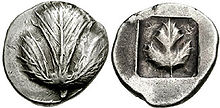
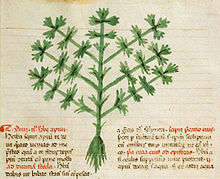
No comments:
Post a Comment